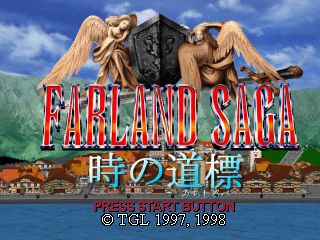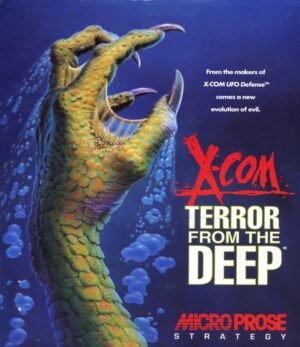Retro Replay Review
Gameplay
Farland Saga: Toki no Michishirube builds upon its predecessor’s strategic RPG foundations by offering expansive, isometric battlefields that demand thoughtful positioning and resource management. Players control an array of characters—each equipped with unique skills and class-specific abilities—and must consider terrain advantages and elemental affinities when planning their moves. The turn-based structure allows for careful deliberation, whether you’re coordinating a multi-character assault on pirate ships or setting up defensive formations in forested passes.
Character progression in Toki no Michishirube is notably flexible. After each skirmish, experience points are pooled and can be freely allocated among party members, granting a sense of agency over class builds and combat roles. You might transform Kalin into a dual-wielding swordswoman one deployment and switch her into a spellcasting prodigy the next—experimentation is both possible and encouraged. This freedom allows players to tailor their squad to preferred playstyles, be it magic-heavy tactics or brute-force melee strategies.
The game also introduces a reputation system tied to the local guild in each town, where mission outcomes influence the variety and quality of available contracts. Deciding whether to accept high-risk bounty hunts against notorious bandits or safer deliver-and-escort tasks injects a welcome strategic layer beyond battlefield skirmishes. Resource gathering and equipment upgrades further enrich the gameplay loop, ensuring that every tough battle and successful contract feels like a meaningful step forward in your mercenary career.
While veteran strategy RPG players will appreciate the depth of tactical options, newcomers might find the initial barrage of menus and mechanics intimidating. Fortunately, the early chapters serve as a gradual tutorial, introducing spells, class promotions, and advanced formations at a measured pace. By midgame, you’ll feel well-versed in the nuances of grid-based warfare and ready to tackle the more challenging pirate captain and monster boss encounters awaiting you on the high seas.
Graphics
Toki no Michishirube sports a vibrant anime-inspired aesthetic that breathes life into its medieval-fantasy world. Character portraits during dialogue are richly detailed, conveying emotions through expressive eyes and dynamic poses. In-battle sprites maintain the same attention to detail, with fluid animations showcasing sword slashes, spellcasting flourishes, and enemy reactions in crisp, colorful frames.
Battle maps are rendered from an isometric perspective, featuring varied environments from pirate-infested coastal outposts to lush, ancient woodlands. Each map is peppered with interactive elements—covering ruins, elevation changes, and environmental hazards—that influence both strategy and visual variety. Watching fire-based spells ripple across wooden decks or ice spells shatter lake surfaces adds a cinematic touch to otherwise methodical combat.
The user interface strikes a balance between clarity and style. Health bars, action menus, and cooldown timers are legible without obscuring the battlefield, while spell icons and status effects carry a consistent design language. Even the item menus and character stat screens bear subtle decorative frames and backgrounds, reinforcing the game’s fantasy setting without sacrificing usability.
Despite its strengths, the graphics engine shows minor performance dips on densely populated maps, with occasional frame rate drops during spell-heavy exchanges. However, these moments are fleeting and do little to detract from the overall visual appeal. In a genre where readability is paramount, Farland Saga: Toki no Michishirube manages to deliver both aesthetic flair and tactical clarity.
Story
The narrative picks up eight years after the climactic war between humans and magical beings, a conflict that reshaped the continent. With Brian—one of the legendary heroes—now deceased, his surrogate daughter Kalin seeks her own path by joining a mercenary guild. This quest for purpose provides a heartfelt throughline as she grapples with her mentor’s legacy and her own emerging powers.
Along the way, Kalin meets Al, a young amnesiac whose wanderlust and forgotten past open avenues for mystery and character growth. Their budding partnership fosters moments of camaraderie, conflict, and occasional humor, making their interactions a highlight of the storyline. Secondary characters—ranging from grizzled captains to scholarly mages—also receive brief but meaningful arcs, often linked to side missions that enrich the world beyond the main quest.
Plot pacing is generally strong, with each new contract or battlefield revealing fresh lore about the pirate factions, the remnants of post-war tensions, and the lingering distrust between races. Cutscenes utilize animated portraits and text-based dialogue, punctuated by occasional voiced exclamations that heighten dramatic moments. Although the overarching plot follows familiar RPG tropes, it injects enough personal stakes and political intrigue to keep players invested through its dozen-or-so chapters.
Some narrative threads, such as exploring the true origins of the magical people or fully uncovering Al’s lost memories, feel slightly underdeveloped and could have benefited from deeper exploration. Yet the game compensates with well-crafted sidequests that delve into local legends and ethical quandaries—ensuring that the story world feels lived-in and ripe for discovery.
Overall Experience
Farland Saga: Toki no Michishirube offers a robust strategy RPG experience that balances tactical depth with a compelling narrative. Its character customization and flexible leveling system provide countless ways to approach battles, whether you prefer blitzkrieg sword charges or carefully timed elemental barrages. Each triumph over a pirate stronghold or bandit camp brings a satisfying sense of progression, both mechanically and narratively.
Audio design complements the visual presentation, with a stirring orchestral score that shifts between triumphant anthems and wistful melodies. Sound effects—from clashing steel to explosive fire spells—are crisp and impactful, lending weight to every strategic maneuver. Although voice acting is limited, its occasional presence enhances key story moments without overstaying its welcome.
On the downside, the game’s difficulty spikes can surprise newcomers, particularly in late-game boss battles that demand mastery of advanced tactics. A few quality-of-life features—such as auto-battle for repetitive encounters or a faster map-navigation option—would have streamlined the experience, but these minor quibbles don’t overshadow the game’s core strengths.
Ultimately, Toki no Michishirube is a worthy sequel for fans of the original Farland Saga and a strong entry point for strategy RPG enthusiasts seeking a richly woven adventure. Its blend of tactical combat, heartfelt storytelling, and anime-inspired visuals makes it a memorable journey across high seas and haunted ruins alike. For players craving both story-driven quests and deep strategic gameplay, this title is well worth adding to the campaign roster.
 Retro Replay Retro Replay gaming reviews, news, emulation, geek stuff and more!
Retro Replay Retro Replay gaming reviews, news, emulation, geek stuff and more!




Reviews
There are no reviews yet.